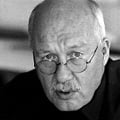
Whoever has dealt with exhibitions and interior design, furniture design or corporate identity concepts in Germany in the last 4 decades – you have to know Rolf Heide, the designer of the stacking lounger, an artistic universal genius, who is never going to deny his spiritual home: apprenticeship as carpenter and the Muthesius handicraft school in Kiel. Since 1960 he is self-employed, counts among the most important European furniture designers and co-invented the discipline of living guidance in magazines. The company Wohnbedarf represents one important station in his life because they used to market his creations (then produced by Müller Möbelwerkstätten) and recently relaunched them. Moreover, Rolf Heide acted as consultant for design-orientated producers like Bulthaup, Interlübke or Vorwerk. In 1999 he received the renowned Karl-Schneider-Prize for Applied Arts and Design.
Biography:
- 1934: Rolf Heide is born in Kiel on January 1st as the eldest son of the family Heide
- 1941: the family moves to Gdingen (formerly Gotenhafen), from there they flee back to Kiel to the grand-parents in 1935, the father dies in the war
- 1950: Rolf Heide starts an apprenticeship as carpenter that he finishes in 1953
- 1953: following the suggestion of his family and also because of the fact that he always wanted to be an architect, he starts an interior architecture study at the Muthesius Handicraft School in Kiel
- 1957: he gets married to Lieselotte Weißferdt; the couple has two sons, Tim and Philipp; for two years Heide works as architect in the studio “Deutsche Werkstätten” in Hamburg
- 1959: he starts his freelance for different magazine publishers, mainly for “Brigitte”; at the same time he makes up his own business as interior architect and designer in Hamburg
- 1968: besides the work as editor, he creates design objects, like, for example, a collection of demountable and transportable furniture pieces; in the end of the 60’s he starts cooperating with the Italian companies DePadova and Bernini.
- 1969: Rolf Heide plans and implements the construction of 3 one-family-houses not far from Hamburg
- 1970: the interior decorator also becomes a freelancer at the magazine „Schöner Wohnen“; this collaboration lasts almost two decades
- 1972: Rolf Heide receives the National Prize for Design for his light system for Wohnbedarf
- 1975: due to the engagement of new employees, his company has to move into a bigger studio in Hamburg-Eppendorf; first jobs for SieMatic, Miele, Stüker, Aske and others follow
- 1978: the close cooperation with the kitchen utensil producer Gaggenau begins; it lasts until the selling of the company in 1993; for Gaggenau he creates exhibitions and catalogues
- 1980: Rolf Heide becomes a freelancer for the magazine “Architektur und Wohnen” for whom he writes, draws and stages
- 1986: collaboration with the carpet producer Vorwerk, for whom the designer organises exhibition stands, advertisements and presentations; moreover he creates his own carpet designs
- 1987: another exclusive furniture producer becomes Heide’s client: For Bulthaup he designs exhibition stands, showrooms, catalogues, advertisements and the book “The Kitchen as Habitat” that is meanwhile published in the third, expanded edition; in addition he comes into contact with the car producers Mercedes Benz, Volkswagen and Opel, and also with Wilkhahn and Lamy
- 1990: for the first time Rolf Heide presents the over-all appearance of several companies for the “Linie 3” at the exhibition “Ambiente” and at the “Frankfurter Herbstmesse”; together with his son Tim he designs the exhibition “Pfau in der Wüste” in the Hamburg Museum of Arts and Industry
- 1992: Rolf Heide is one of the first ten designers that are invited to participate in the Ritzenhof frosted glass collection; for the first time he organises the special exhibition “Atmosphere” for different textile producers at the exhibition “Heimtex” in Frankfort
- 1993/94: as first retrospect, the exhibition “Rudolf Heide – interior architect, designer, conceptionist” from the International Design Centre in Berlin dignifies his work; on the occasion of the Hamburg Architecture Summer the exhibition in the Hamburg Museum for Art and Industry is also shown in an expanded form; the designer starts his engagement for the jalousie manufacturer Vossloh and is in charge of the interior architectural planning of the design store “Stilwerk” near the harbour of Hamburg; as a member of the board of trustees he joins the Raymond Loewy Foundation
- 1995/96: together with his son Tim he wins the competitive bidding of a presentation for the Telekom concurrence Vebacom; the creation is implemented in the next year